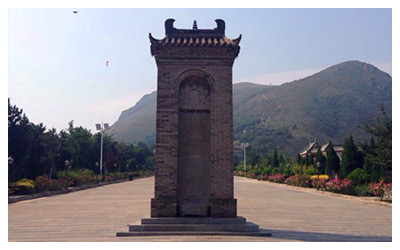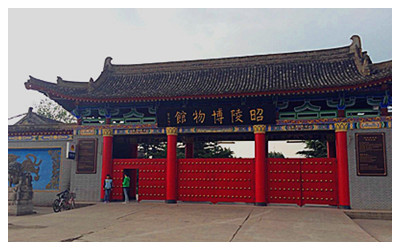Skype: neodalle-travel
Tel: +86 135 7447 2266
E-mail: sales@zhangjiajieholiday.com
Features
 Zhaoling was designed by Yan Lide, a famous architect in the Tang Dynasty. Originally, before they dug the tomb from half of the cliff to the bottom of the mountain, they built a plank road along the face of the cliff. It is said the tomb passage is about 230meters deep. After the burial of Emperor Taizong, the opening of the tomb passage was closed with 3000 pieces of rocks, each weighs 2 tons and was fastened with iron belt. The crack between rocks was filled in with liquid iron. When the project was completed, the plank road was fired, this effectively cut the connection between the tomb and the outside, It makes it quite difficult for the tomb robbers to rob the tomb. It is said about 10th century a warlord named Wentao once robbed the tomb. But in the past 30 years the archeologists did a lot of investigations to the underground palace of Zhaoling after their study of historical document about robbery. This will be proved after the excavation of the tomb.
Zhaoling was designed by Yan Lide, a famous architect in the Tang Dynasty. Originally, before they dug the tomb from half of the cliff to the bottom of the mountain, they built a plank road along the face of the cliff. It is said the tomb passage is about 230meters deep. After the burial of Emperor Taizong, the opening of the tomb passage was closed with 3000 pieces of rocks, each weighs 2 tons and was fastened with iron belt. The crack between rocks was filled in with liquid iron. When the project was completed, the plank road was fired, this effectively cut the connection between the tomb and the outside, It makes it quite difficult for the tomb robbers to rob the tomb. It is said about 10th century a warlord named Wentao once robbed the tomb. But in the past 30 years the archeologists did a lot of investigations to the underground palace of Zhaoling after their study of historical document about robbery. This will be proved after the excavation of the tomb.
What to see?
Covering an area of 87.5 square miles, Zhao Mausoleum has 190 satellite tombs that have been verified with 37 which have been excavated. The owners of the satellite tombs include famous ministers, royal families and high officials. All five forms of satellite burials in history have been represented here thereby justifying Zhaoling Mausoleum as the most typical imperial mausoleum in China.
Emperor Taizong's Tomb
The configuration of Emperor Taizong's tomb as it overlooks the satellite ones symbolizes the utmost authority of the emperor. The style of Zhaoling Mausoleum as it is set against the mountain is a miniature of the renovation in Tang Dynasty. Record has it that before her death, Empress Wende told Emperor Taizong that her burial site should be placed against a mountain so that there would be no need to build a tomb. After her burial, the Emperor wrote on the tombstone that an emperor regarded the whole world as his family. Around Zhaoling Tomb, there are 167 satellite tombs according to the historical document, but according to the recent remote sensing test, 188 satellite tombs are still there. They were arranged in accordance with the relation of the tomb host to the Emperor Taizong.
Zhaoling Museum
 Inside the Zhaoling Museum except the Tomb of Li Bo there are two exhibition halls of stone tablets and the hall of unearthed articles, sculptures and paintings. On display here are not only the relics recently excavated from a dozen of accompanied tombs but also various kinds of broken pieces of epitaphs of the Tang Dynasty. Because of the great value out from these broken pieces of calligraphic scriptures the Zhaoling Museum is also known as “Zhaoling Forest of Steles”. On display in the first exhibition are 20 pieces of epitaphs including the tablet to Wen Yanbo inscribed by QuYangxun, tablet to FangXuanling written by Chu Suiliang, tablets to Li Jing and Yuchi Jingde by WangZhijing, tablet for Gao Shilian by Zhao Mo and tablet for Ma Zhou by Yin Zhongrong as well as the tablet for Du Junchuo by Gao Zhengjun and so on, During early Tang Dynasty the regular script was very popular. The most famous calligraphers of the time are OuYang xun, Chu Suiliang, Yu Shinan and Xueji, being regarded as the “Four Great Calligraphers” in the initial days of the Tang Dynasty. Here we can enjoy their model calligraphic works.
Inside the Zhaoling Museum except the Tomb of Li Bo there are two exhibition halls of stone tablets and the hall of unearthed articles, sculptures and paintings. On display here are not only the relics recently excavated from a dozen of accompanied tombs but also various kinds of broken pieces of epitaphs of the Tang Dynasty. Because of the great value out from these broken pieces of calligraphic scriptures the Zhaoling Museum is also known as “Zhaoling Forest of Steles”. On display in the first exhibition are 20 pieces of epitaphs including the tablet to Wen Yanbo inscribed by QuYangxun, tablet to FangXuanling written by Chu Suiliang, tablets to Li Jing and Yuchi Jingde by WangZhijing, tablet for Gao Shilian by Zhao Mo and tablet for Ma Zhou by Yin Zhongrong as well as the tablet for Du Junchuo by Gao Zhengjun and so on, During early Tang Dynasty the regular script was very popular. The most famous calligraphers of the time are OuYang xun, Chu Suiliang, Yu Shinan and Xueji, being regarded as the “Four Great Calligraphers” in the initial days of the Tang Dynasty. Here we can enjoy their model calligraphic works.
On display in the second exhibition are some stone tablets and epitaphs discovered in the past forty years. Such as “Zhou Hu Tablet” written by Wang Xingman; “The Tablet of Li Mengchang” written by Li Xuanzhi and some tablets written anonymously, during the scores of years in the past, about a dozen of accompanied tombs have been excavated in the Zhaoling Tomb area.
Travel Tips
How to get there: Take a bus from South Bus Station to Yuanjiacun Village. And then you can follow the above route to Zhaoling Museum and Zhaoling Mausoleum.
Entrance Fee: CNY 70 (includes Zhaoling MMausoleum and Zhaoling Museum)
Opening hours: 08:00-17:30
 Ask Questions ?
Ask Questions ?